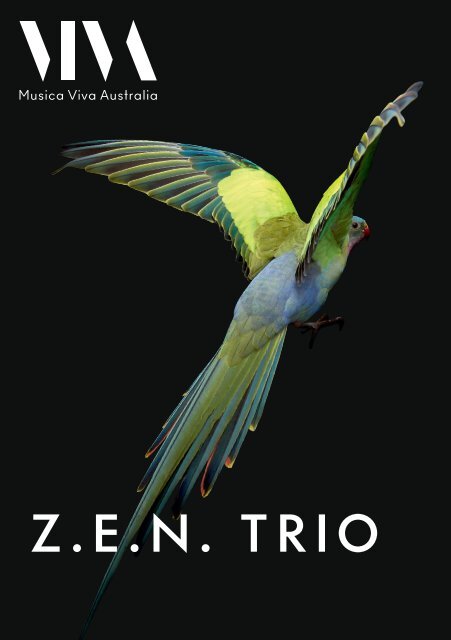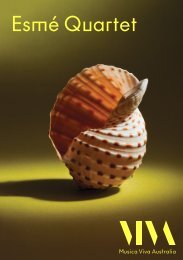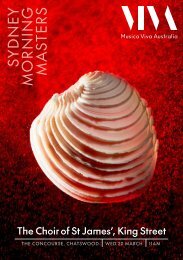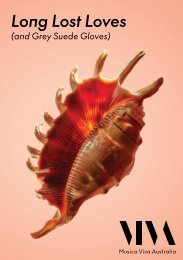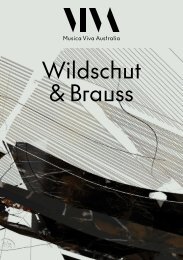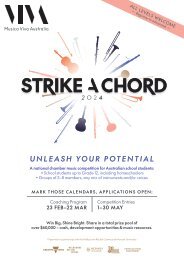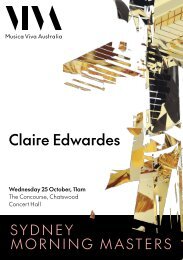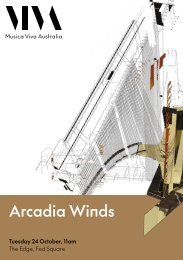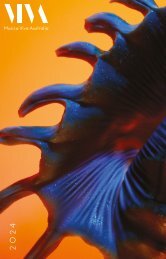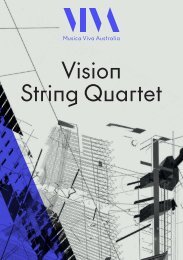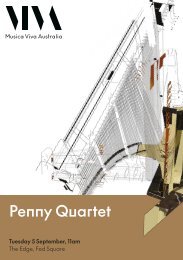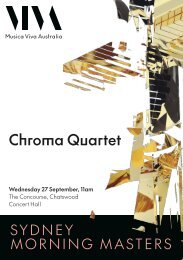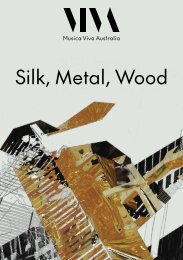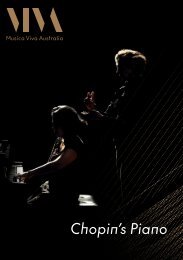Z.E.N. Trio Program Guide | August 2022
Create successful ePaper yourself
Turn your PDF publications into a flip-book with our unique Google optimized e-Paper software.
Z.E.N. TRIO
2
Musica Viva Australia acknowledges the Traditional Custodians of the many lands on which we<br />
meet, work and live. We pay our respects to their Elders past and present – people who have<br />
sung their songs, danced their dances and told their stories on these lands<br />
for thousands of generations, and who continue to do so.<br />
Z.E.N. TRIO<br />
ESTHER YOO<br />
Violin<br />
NAREK HAKHNAZARYAN<br />
Cello<br />
ZHANG ZUO<br />
Piano<br />
ADELAIDE<br />
Adelaide Town Hall<br />
Thursday 25 <strong>August</strong>, 7.30pm<br />
• Pre-concert talk: 6:45pm,<br />
Prince Alfred Room<br />
• Meet the Artists after the concert<br />
CANBERRA<br />
Llewellyn Hall,<br />
ANU School of Music<br />
Thursday 18 <strong>August</strong>, 7pm<br />
• Pre-concert talk: 6:15pm,<br />
Larry Sitsky Room<br />
NEWCASTLE<br />
Newcastle City Hall<br />
Saturday 27 <strong>August</strong>, 7.30pm<br />
• Pre-concert talk: 6:45pm,<br />
Mulubinba Room<br />
• Meet the Artists after the concert<br />
PERTH<br />
Perth Concert Hall<br />
Recorded for broadcast by ABC Classic<br />
Monday 15 <strong>August</strong>, 7.30pm<br />
• Pre-concert talk: 6:45pm,<br />
Corner Stage Riverside, Terrace Level<br />
|<br />
1<br />
|<br />
MELBOURNE<br />
Elisabeth Murdoch Hall,<br />
Melbourne Recital Centre<br />
Saturday 13 <strong>August</strong>, 7pm<br />
• Pre-concert talk: 6:15pm,<br />
Salzer Suite, Level 2<br />
• Meet the Artists after the concert<br />
Tuesday 23 <strong>August</strong>, 7pm<br />
This concert will be livestreamed<br />
• Pre-concert talk: 6:15pm,<br />
Salzer Suite, Level 2<br />
SYDNEY<br />
City Recital Hall<br />
Saturday 20 <strong>August</strong>, 2pm<br />
• Pre-concert talk, 1:15pm,<br />
Function Room<br />
• Meet the Artists after the concert<br />
Monday 22 <strong>August</strong>, 7pm<br />
Charles Berg Tribute Concert<br />
• Pre-concert talk, 6:15pm,<br />
Function Room<br />
• CD Signing after the concert<br />
With special thanks to the Australian Music Foundation for their support of this tour,<br />
and to the Producers’ Circle and Amadeus Society for their support of the <strong>2022</strong> Concert Season.<br />
Cover photo: Copyright Gary Heery
PROGRAM 1<br />
Canberra<br />
Sydney<br />
Melbourne<br />
Adelaide<br />
Thu 18 <strong>August</strong>, 7pm<br />
Sat 20 <strong>August</strong>, 2pm<br />
Tue 23 <strong>August</strong>, 7pm<br />
Thu 25 <strong>August</strong>, 7:30pm<br />
Johannes BRAHMS (1833–1897)<br />
Piano <strong>Trio</strong> No. 1 in B Major, Op. 8 (Revised version, 1889)<br />
I Allegro con brio (Fast and spirited) – Tranquillo (Calmly) –<br />
In tempo ma sempre sostenuto (In time but always sustained)<br />
II Scherzo: Allegro molto (Very fast) – Meno allegro (Less fast) –<br />
Tempo primo (At the original tempo)<br />
III Adagio (Slow)<br />
IV Finale: Allegro (Fast)<br />
35 min<br />
INTERVAL<br />
|<br />
2<br />
|<br />
Matthew LAING (b 1988)<br />
Little Cataclysms (<strong>2022</strong>)<br />
Commissioned for Musica Viva Australia by Graham Lovelock and Steven Singer<br />
World premiere performances<br />
Arno BABAJANIAN (1921–1983)<br />
<strong>Trio</strong> for Piano, Violin and Cello in F-Sharp Minor (1952)<br />
I<br />
II<br />
III<br />
Largo (Slow and broad) – Allegro espressivo (Fast and expressive)<br />
Andante (Moving along at an easy walking pace)<br />
Allegro vivace (Fast and lively)<br />
12 min<br />
24 min<br />
REGIONAL TOURING<br />
The Z.E.N. <strong>Trio</strong> will perform at the<br />
Macquarie Conservatorium in Dubbo,<br />
NSW on Wednesday 10 <strong>August</strong> and in<br />
Hobart Town Hall, Tasmania on<br />
Friday 12 <strong>August</strong> as part of Musica Viva<br />
Australia’s Regional Touring <strong>Program</strong>.<br />
For further details visit:<br />
musicaviva.com.au/regional
PROGRAM 2<br />
Melbourne<br />
Perth<br />
Sydney<br />
Newcastle<br />
Sat 13 <strong>August</strong>, 7pm<br />
Mon 15 <strong>August</strong>, 7:30pm<br />
Mon 22 <strong>August</strong>, 7pm<br />
Sat 27 <strong>August</strong>, 7:30pm<br />
Arno BABAJANIAN (1921–1983)<br />
<strong>Trio</strong> for Piano, Violin and Cello in F-Sharp Minor (1952)<br />
I<br />
II<br />
III<br />
Largo (Slow and broad) – Allegro espressivo (Fast and expressive)<br />
Andante (Moving along at an easy walking pace)<br />
Allegro vivace (Fast and lively)<br />
Matthew LAING (b 1988)<br />
Little Cataclysms (<strong>2022</strong>)<br />
Commissioned for Musica Viva Australia by Graham Lovelock and Steven Singer<br />
World premiere performances<br />
24 min<br />
12 min<br />
INTERVAL<br />
Antonín DVOŘÁK (1841–1904)<br />
Piano <strong>Trio</strong> No. 4 in E Minor, Op. 90 ‘Dumky’ (1891)<br />
I<br />
II<br />
III<br />
IV<br />
V<br />
VI<br />
Lento maestoso (Slow and majestic) – Allegro vivace (Fast and lively)<br />
Poco adagio (A little slow)<br />
Andante (Moving along at an easy walking pace)<br />
Andante moderato (Moving along at a moderate pace)<br />
Allegro (Fast)<br />
Lento maestoso (Slow and majestic) – Vivace (Lively)<br />
32 min<br />
|<br />
3<br />
|<br />
MASTERCLASSES<br />
The Z.E.N. <strong>Trio</strong> will present the following<br />
masterclasses as part of this tour:<br />
• Dubbo: Tue 9 <strong>August</strong> (Zee Zee)<br />
Macquarie Conservatorium<br />
• Perth: Wed 17 <strong>August</strong> (Narek)<br />
University of Western Australia, Callaway Auditorium<br />
• Sydney: Mon 22 <strong>August</strong> (Narek)<br />
Conservatorium of Music<br />
Musica Viva Australia’s Masterclass<br />
program is supported by:<br />
Nicholas Callinan AO & Elizabeth Callinan<br />
Caroline & Robert Clemente<br />
Ian & Caroline Frazer<br />
The Patricia H Reid Endowment Fund<br />
Andrew Sisson AO & Tracey Sisson<br />
Mick & Margaret Toller<br />
Anonymous (1)<br />
For further details visit: musicaviva.com.au/masterclasses
FROM THE ARTISTIC DIRECTOR<br />
One of the most inspiring aspects of working with<br />
young musicians is watching them shift from learning<br />
their instruments and craft, to them realising that<br />
they have an implicit responsibility to repertory from<br />
the last 400 years or more. (Of course, Indigenous<br />
musical traditions in this country go back many<br />
more thousands of years.) Thus it was with the<br />
members of the Z.E.N. <strong>Trio</strong>, who met as soloists<br />
on the BBC’s prestigious New Generation scheme<br />
before recognising that their compatibility and love<br />
of the piano trio repertory made them such natural<br />
collaborators.<br />
|<br />
4<br />
|<br />
© Keith Saunders<br />
Solo repertory requires a different performance<br />
psychology, whether in concerto or in recital; the<br />
economy of the former allows so little time for<br />
meaningful collaboration, while the latter frequently<br />
places the spotlight on the soloist alone, despite<br />
the distinguished associate artist up there on stage.<br />
Chamber repertory demands an entirely equal<br />
partnership, a different way of rehearsing, and often<br />
different performance venues too. My favourite<br />
musicians are those who can do all three with equal<br />
assuredness, which is what makes these three artists<br />
– Zee Zee, Esther and Narek – so compelling in this<br />
great trio repertory.<br />
There is a fourth. Matthew Laing – a lovely violist<br />
in his own right – is fast emerging as one of the<br />
most thoughtful and vibrant compositional voices<br />
in Australia today. Haydn wrote piano trios, though<br />
it took Mozart to balance the voices and establish<br />
a template for the genre into the 19th century and<br />
beyond. Asked to add to this genre, Matthew<br />
has responded with a work of great complexity,<br />
colour and virtuosity, which receives its premiere<br />
on this tour thanks, in part, to the generosity of the<br />
commissioners, Graham Lovelock and Steven Singer.<br />
Paul Kildea<br />
Artistic Director<br />
Musica Viva Australia
MEET THE ARTISTS<br />
ESTHER YOO<br />
In an era when technical perfection is a<br />
given, the spotlight inevitably shifts to<br />
interpretation, and Esther Yoo’s playing has<br />
been described as ‘mesmerising’, ‘soulful’,<br />
‘spellbinding’, ‘intensely lyrical’, and ‘taking<br />
her audience into an enchanted garden’. She<br />
performs with leading conductors – including<br />
Vladimir Ashkenazy (with whom she and the<br />
Philharmonia Orchestra recorded the Sibelius,<br />
Glazunov and Tchaikovsky concertos for<br />
Deutsche Grammophon), Gustavo Dudamel,<br />
Esa-Pekka Salonen, Thierry Fischer, Karina<br />
Canellakis and Andrew Davis – and orchestras<br />
such as the Los Angeles Philharmonic, BBC<br />
Symphony Orchestra, Seoul Philharmonic,<br />
Deutsche Radio Philharmonie and the<br />
Royal Liverpool Philharmonic. The Royal<br />
Philharmonic Orchestra appointed her as their<br />
inaugural Artist-in-Residence in 2018.<br />
Esther has appeared in recital at the Lincoln<br />
Center and Wigmore Hall, and in 2018<br />
featured prominently on the soundtrack and<br />
accompanying Decca soundtrack recording<br />
of the feature film On Chesil Beach. She has<br />
also performed at a range of prominent<br />
festivals including the BBC Proms and Aspen<br />
Music Festival. The piano trio Z.E.N. (which<br />
she co-founded with fellow former BBC Radio 3<br />
New Generation Artists Zhang Zuo and Narek<br />
Hakhnazaryan) tours widely in North America,<br />
Europe, Asia and Australia.<br />
Esther may be unique among classical soloists<br />
in being fully tri-cultural. She was born and<br />
spent her earliest years in the US, before<br />
receiving her education in Belgium and<br />
Germany, but she always retained her family’s<br />
proud Korean heritage. Having authentic roots<br />
in three continents may have contributed to<br />
her versatility and exceptionally broad range<br />
of expression, and was unquestionably a<br />
factor in making her one of the most articulate<br />
and gifted communicators in the field of<br />
classical music.<br />
She began playing the violin at four, and<br />
made her concerto debut aged eight. At 16<br />
she became the youngest prize-winner of the<br />
International Sibelius Violin Competition and<br />
two years later, in 2012, she was one of the<br />
youngest ever priz-ewinners of the Queen<br />
Elisabeth Competition. In 2014 she became a<br />
BBC Radio 3 New Generation Artist and in 2018<br />
Classic FM featured her in their Top 30 Artists<br />
under 30.<br />
NAREK HAKHNAZARYAN<br />
Since winning the Cello First Prize and Gold<br />
Medal at the XIV International Tchaikovsky<br />
Competition in 2011 at the age of 22, Narek<br />
Hakhnazaryan has performed with most<br />
major orchestras and in recital and chamber<br />
music across the globe. He has been praised<br />
as ‘dazzlingly brilliant’ (The Strad) and<br />
‘nothing short of magnificent’ (San Francisco<br />
Chronicle); of his Los Angeles Philharmonic<br />
Orchestra debut, the LA Times described his<br />
command of the instrument as ‘extraordinary.’<br />
He has appeared with orchestras such as<br />
the London, Chicago, Pittsburgh and Sydney<br />
Symphony Orchestras, the London, Rotterdam,<br />
Czech, Seoul, LA and Royal Stockholm<br />
Philharmonic Orchestras, Tokyo’s NHK<br />
Symphony, the Frankfurt Radio Symphony<br />
Orchestra, Berlin Konzerthaus Orchestra,<br />
Estonian National Symphony Orchestra<br />
and Orchestre de Paris. A former BBC New<br />
Generation Artist, he has performed with all<br />
the BBC orchestras and at the BBC Proms. In<br />
2017 the Vienna Konzerthaus invited Narek<br />
|<br />
5<br />
|
|<br />
6<br />
|<br />
onto their Great Talent program; during the<br />
two seasons that followed he performed<br />
there regularly in recital, chamber music<br />
and with orchestra, most notably with the<br />
Vienna Symphony. He was the 2020/21 Artist<br />
in Residence at the Finnish Radio Symphony<br />
Orchestra.<br />
Recent recital highlights include performances<br />
with Daniil Trifonov at the Verbier and<br />
Rheingau Festivals, concerts at Carnegie<br />
Hall and Boston’s Jordan Hall, a four-concert<br />
residency at London’s Wigmore Hall, and a<br />
tour of SE Asia performing the complete Bach<br />
solo cello suites.<br />
Mentored by the late Rostropovich, in 2011<br />
Narek received an Artist Diploma from the<br />
New England Conservatory of Music, where<br />
he studied with Lawrence Lesser. Prior to this<br />
he studied at the Moscow Conservatory and<br />
at the Sayat-Nova School of Music in Yerevan,<br />
Armenia. He was the First Prize winner in<br />
the 2006 Aram Khachaturian International<br />
Competition and the 2008 Young Concert<br />
Artists International Auditions.<br />
Born in Yerevan into a family of musicians,<br />
Narek performs regularly with his brother,<br />
the conductor Tigran Akhnazarian. In 2017 he<br />
was awarded the title of ‘Honoured Artist of<br />
Armenia’. He plays the 1707 Joseph Guarneri<br />
cello with bows by François Xavier Tourte and<br />
Benoît Rolland.<br />
ZHANG ZUO<br />
An imaginative and electrifying performer,<br />
Zhang ‘Zee Zee’ Zuo is unique among<br />
the young generation of pianists. Her<br />
interpretations have been praised as ‘taking<br />
us to another reality... bright, expressive<br />
and moving to the extreme’ (Belgian<br />
Broadcasting), while her creative maturity has<br />
been hailed as ‘a powerful, passionate and<br />
compelling representation of pure artistry’<br />
(Los Angeles Times).<br />
Recent highlights include concerts with the<br />
Estonian National Symphony Orchestra,<br />
the China and Hong Kong Philharmonic<br />
Orchestras and the Philharmonia Orchestra,<br />
as well as the complete piano concertos of<br />
Beethoven and Saint-Saëns with the Shanghai<br />
Symphony Orchestra. She has also appeared<br />
with the BBC Symphony and BBC Philharmonic<br />
Orchestras, the London, Warsaw, Los Angeles<br />
and Royal Liverpool Philharmonic Orchestras,<br />
the San Francisco, Minnesota, Cincinnati<br />
and Seattle Symphony Orchestras, Belgian<br />
National Orchestra, Tonhalle Orchestra<br />
Zurich and Tokyo’s NHK Symphony Orchestra,<br />
among others.<br />
She has given recitals at Wigmore Hall and the<br />
Kennedy and Lincoln Centers, and appeared<br />
at Italy’s MiTo Festival, the Lucerne Festival, the<br />
Aspen Music Festival and the BBC Proms.<br />
Zee Zee was a BBC New Generation Artist<br />
from 2013 to 2015.<br />
Zee Zee began her musical training in<br />
Germany at the age of five. Upon returning<br />
to her native China, she became one of the
most sought-after young artists in the nation,<br />
collaborating with the leading Chinese<br />
orchestras, with whom she retains a close link.<br />
Having completed her piano studies at the<br />
Shenzhen Arts School, Zee Zee was invited<br />
to continue her artistic development at the<br />
Eastman School of Music and the Juilliard<br />
School, where she won the coveted Petschek<br />
Piano Award. She has studied at the Peabody<br />
Institute and continues to receive guidance<br />
from Alfred Brendel.<br />
Zee Zee was the winner of China’s first<br />
International Piano Concerto Competition,<br />
the Gina Bachauer International Piano<br />
Competition and the Krainev International<br />
Piano Competition, and a prize-winner at the<br />
2013 Queen Elisabeth Competition. Her first<br />
album, Ravel’s Piano Concerto in G and Liszt’s<br />
Piano Concerto No. 2 with Paavo Järvi and the<br />
Philharmonia Orchestra, was released in 2019;<br />
a solo album, Journey, featuring works by<br />
Wagner, Schoenberg and Liszt, was released<br />
in May this year.<br />
MATTHEW LAING<br />
Matthew Laing is a freelance composer and<br />
viola player currently based in Melbourne,<br />
Australia. His music, described as ‘thought<br />
provoking and unusually beautiful’, is<br />
fundamentally driven by an interest in storytelling<br />
through sound, typically around themes<br />
of social connection and environment.<br />
Matthew has been writing music since he<br />
started university, sketching ideas whilst<br />
training to be a viola player, and completing<br />
a Bachelor of Music/Bachelor of Commerce<br />
at the University of Melbourne. Following<br />
a successful participation in the Flinders<br />
Quartet’s 2017 composer workshop, his first<br />
big commission, Out of Hibernation, was<br />
premiered by the Quartet in 2019; this led to<br />
an Ian Potter Cultural Trust grant to work on<br />
the quartet with mentoring from Brett Dean in<br />
London and Berlin.<br />
Having participated in the Melbourne<br />
Symphony Orchestra’s 2020 Young Composer<br />
program, he was selected as the orchestra’s<br />
Young Composer in Residence for 2021,<br />
culminating in the premiere of his bassoon<br />
concerto Of Paradise Lost in July <strong>2022</strong>.<br />
Matthew was a recipient of a 2021 Prelude<br />
Residency through the Peggy Glanville-Hicks<br />
Composer House Trust, and is a Musica Viva<br />
Australia FutureMaker for 2021–23.<br />
His work Portrait of Blood, for string quartet<br />
and mezzo-soprano, was performed in<br />
London on a tour by Affinity Quartet and<br />
Lotte Betts-Dean in February 2020. Other<br />
compositional engagements have included<br />
works for the Australian String Quartet, the<br />
Melbourne Chamber Orchestra, Melbourne<br />
Symphony Orchestra, Melbourne Chamber<br />
Players, Wattleseed Ensemble and ANAM.<br />
FURTHER EXPLORATION<br />
The Z.E.N. <strong>Trio</strong> has released two albums<br />
on the Deutsche Grammophon label.<br />
The first, Brahms & Dvořák Piano <strong>Trio</strong>s,<br />
released in 2017, features sparkling<br />
recordings of Brahms’ Piano <strong>Trio</strong> No. 1<br />
and Dvořák’s ‘Dumky’ Piano <strong>Trio</strong>, Op. 90.<br />
Burning Through the Cold, released<br />
in 2020, features piano trios by<br />
Babajanian and Shostakovich as well as<br />
arrangements by the <strong>Trio</strong> of works<br />
by Khachaturian and Rachmaninoff.<br />
The Z.E.N. <strong>Trio</strong>’s discography can be<br />
found on their website: zen-trio.com<br />
Matthew Laing’s music has been<br />
performed by artists including the<br />
Melbourne Symphony Orchestra, Flinders<br />
Quartet, Katie Yap and Lily Bryant.<br />
Videos and audio recordings can be<br />
found on his website: mattlaing.com<br />
|<br />
7<br />
|
|<br />
8<br />
|<br />
ABOUT THE MUSIC<br />
Brahms’s B Major Piano <strong>Trio</strong> is, paradoxically,<br />
a product of both his youth and his maturity.<br />
He first sketched it out in 1853, and it was<br />
among the draft works which the 20-year-old<br />
composer showed to Schumann when the two<br />
met in September that year. It was published<br />
as Brahms’s Opus 8 in 1854. However, over 30<br />
years later in 1889, with the prospect of another<br />
edition of the work going to press, Brahms<br />
thoroughly revised and altered it. Among the<br />
many changes were drastic cuts to all but the<br />
principal thematic material in the first and last<br />
movements; the re-working of entire sections<br />
in the central part of the slow movement;<br />
and further cuts to the development section<br />
and the omission of a fugal episode in the<br />
first movement. If something of the work’s<br />
rambling, youthful Romanticism was lost in<br />
the process, along with over a third of its<br />
considerable length, the new version (which<br />
is the one generally in use today) certainly<br />
gained a clearer formal logic. In its new guise,<br />
it loses nothing in comparison with the Clarinet<br />
<strong>Trio</strong> which Brahms wrote only two years after<br />
the revision, in 1891.<br />
Despite the shortened treatment of subsequent<br />
themes, some 40 bars are spent over the<br />
statement of the first movement’s broad<br />
principal theme. Like Schubert in his later<br />
instrumental works, the young Brahms often<br />
chose to open his works with spacious, lyrical<br />
themes. These, though beautiful in themselves,<br />
do not always contain the pithy motifs needed<br />
for tight, concentrated musical argument, and<br />
thus applied to sonata forms inevitably gave<br />
rise to long, leisurely movements. In this case,<br />
however, potential longueurs are cast out by<br />
the sheer verve and enthusiasm of the music,<br />
by a combination of soaring melodies and<br />
ebullient pianism, plainly tailored to Brahms’s<br />
own arresting pianistic style. Time after time,<br />
the trio conjures up visions of the burly young<br />
virtuoso, his arms flung wide to the extremes<br />
of the keyboard, revelling in the increasingly<br />
powerful sonorities of the still-evolving<br />
pianoforte.<br />
Even in this early work, many other hallmarks<br />
of the mature Brahmsian style are present:<br />
the energetic Gypsy (Romá)-like rhythms; the<br />
sonorous effect of melodies doubled in thirds<br />
and sixths; a fascination with falling thirds; and<br />
a unique attraction to the lowest registers of<br />
the keyboard. Brahms also reveals a tendency<br />
to darken the mood towards the end of a work.<br />
As early as the Scherzo, the work leaves<br />
B major for B minor, alternating with B major<br />
for the movement’s trio section and then for<br />
the slow movement, but finding itself caught up<br />
inextricably in the tonic minor for the finale.<br />
Returning to the second movement, we find<br />
Brahms’s first thoughts virtually unchanged by<br />
the 1889 revision, and the young composer’s<br />
nationalistic fascination with German folk<br />
culture is still sung to the full in the opening<br />
hunting horn motif. This scrap of rustic melody<br />
is curiously reminiscent, albeit through the<br />
filter of a minor key, of the scherzo theme<br />
from Schubert’s Octet; but (written in 1853) it<br />
also points forward, inevitably, to the finale of<br />
Brahms’s Horn <strong>Trio</strong> of 1868.<br />
Another ‘ghost’, that of Beethoven, is conjured<br />
up in the hymn-like piano writing at the<br />
opening of the Adagio, with full chords<br />
simultaneously high and low in the piano’s<br />
register. Moving further into the movement,<br />
the polished surface of the middle sections<br />
gives no hint of the extensive revisions
performed upon them, although the finely<br />
wrought chromaticism does perhaps reveal the<br />
defter touch of the older Brahms. In contrast,<br />
the opening of the B minor Finale sounds<br />
very much like the young Brahms’s attempt,<br />
in its impetuous, lightly accompanied cello<br />
melody, to pay homage to the much-admired<br />
Schumann (remember, it was drafted just<br />
before the two first met). But here too, it doesn’t<br />
take long for the younger composer’s vigour<br />
to assert itself, and the final pages are entirely<br />
Brahmsian.<br />
a bit dark, but also because I don’t want the<br />
piece to be too prescriptive. Little Cataclysms is<br />
about intimate, personal disasters in miniature<br />
form – like a deep-seeded memory awoken,<br />
reimagined changed or unchanged, then<br />
gone, where the reimagining informs the<br />
memory in the silence that follows.<br />
© MATTHEW LAING <strong>2022</strong><br />
Little Cataclysms was commissioned for Musica Viva<br />
Australia by Graham Lovelock and Steven Singer.<br />
© MUSICA VIVA AUSTRALIA<br />
Arno Babajanian began his musical studies<br />
at seven in a special program for talented<br />
children at the Komitas State Conservatory<br />
in Yerevan. His playing soon caught the<br />
ear of his more famous compatriot, Aram<br />
Khachaturian, who recommended he go to<br />
Moscow to study piano and composition. His<br />
study was interrupted by five years of war, but<br />
in 1946 he returned to Moscow, and in 1950 he<br />
won a prestigious Stalin Prize for his Heroic<br />
Ballad for Piano and Orchestra. This was it, the<br />
official stamp of approval, prompting Dmitri<br />
Shostakovich to write, ‘Arno Babajanian is<br />
a great musician gifted with compositional<br />
talent.’<br />
|<br />
9<br />
|<br />
Matthew Laing writes:<br />
Little Cataclysms plays on the idea of scale and<br />
proportion, and a little bit on the melodrama<br />
typical of Romantic-era works, when the piano<br />
trio probably had its greatest era. Piano trios<br />
naturally lend themselves to large-scale works,<br />
so I wanted to try and recreate that, just in<br />
small timeframes, hence the paradox ‘Little<br />
Cataclysms’.<br />
Each of these five pieces was initially inspired<br />
by a line from a song or poem, but I’ve left<br />
these out of the piece, in part because they’re<br />
You can hear a heady mixture of musical<br />
influences in his Piano <strong>Trio</strong>: the emotional rush<br />
and spectacular pianism of Rachmaninoff,<br />
the timbral colours of Glazunov and Rimsky-<br />
Korsakov, and the directness of Shostakovich.<br />
But in spite of his immersion in the Soviet<br />
school of composition, Babajanian’s Armenian<br />
identity is at the heart of his music. His long,<br />
yearning melodies, which, to an ear used<br />
to Western harmony, sound like they are<br />
wandering far from home, and his use of crossrhythms<br />
and rapidly changing time signatures<br />
are all part of a rich tradition.<br />
Bartók and Kodály are often cited as the first<br />
ethnomusicologists, collecting and transcribing<br />
traditional Bulgarian and Romani songs at the<br />
start of the 20th century. But a decade before
|<br />
10<br />
|<br />
ABOUT THE MUSIC<br />
Bartók there was Komitas, an Armenian priest<br />
and musicologist, collecting and transcribing<br />
Armenian folk songs and Kurdish melodies.<br />
His work was cut short by the genocide inflicted<br />
on Armenia by the Ottoman Empire in 1915, but<br />
his legacy as founder of the Armenian national<br />
school of music lives on.<br />
The Piano <strong>Trio</strong> in F-Sharp Minor, written in<br />
1952, is shot through with melodies derived<br />
from the traditional folk songs at the heart<br />
of Babajanian’s musical upbringing. Sacred<br />
chants, love songs, dances and ballads find<br />
their way into every corner of the trio, from the<br />
opening melody, to the horovel, the song of the<br />
ploughman, the antuni, song of the migrant, to<br />
the kochari dance.<br />
The first movement opens with violin and cello<br />
playing a sombre melody reminiscent of the<br />
sharakan, the liturgical chant of Armenian<br />
Apostolic Church. It has also been identified<br />
as the Armenian folk song Garuna, or<br />
‘Springtime’. The theme reappears at key<br />
moments throughout the work in different<br />
guises. Here the hushed, introspective mood<br />
gives way to the theme becoming a Romantic<br />
song, building to a passionate outpouring of<br />
emotion.<br />
The second movement opens with an exquisite,<br />
searching melody, an antuni or migrant’s<br />
song, played in the top register of the violin,<br />
accompanied by gentle, rocking chords in<br />
the piano. The floating calm is disrupted by a<br />
more chromatic middle section, interrupted<br />
by an emphatic restatement of our old friend,<br />
‘Springtime’, before the antuni returns, in all its<br />
fragile beauty.<br />
The third movement leaps into a spirited<br />
kochari, a men’s stomping dance full of tricksy<br />
cross-rhythms and changes in meter, ready<br />
to trip up the unwary. The central section<br />
introduces a more sensual mood, although no<br />
let up in the headlong pace, before returning<br />
to the opening kochari, appearing this time<br />
as a foot-tangling fugue. It all comes to a<br />
juddering halt as Babajanian clears the deck<br />
to revisit his opening theme, ‘Springtime’,<br />
rescored in rich harmony, before a final dance<br />
to the end.<br />
© HARRIET CUNNINGHAM <strong>2022</strong><br />
In 1891 Antonín Dvořák was riding a wave<br />
of international acclaim. He toured to Britain<br />
and Russia for performances of his Eighth<br />
Symphony and Requiem. He was awarded<br />
an honorary doctorate from Cambridge<br />
University, and invited to take up the<br />
directorship of the newly established American<br />
Conservatory of Music in New York.<br />
On 11 April of that same year, on the occasion<br />
of his accepting another honorary doctorate,<br />
this time from Prague’s Charles University, he<br />
gave the premiere of his Fourth Piano <strong>Trio</strong>, the<br />
‘Dumky’, alongside violinist Ferdinand Lachner<br />
and cellist Hanuš Wihan.<br />
In a letter to his friend Alois Göbl, Dvořák<br />
described the work as ‘a little piece for violin,<br />
cello and piano. It will be both happy and sad.<br />
In some places it will be like a melancholic<br />
song, elsewhere like a merry dance; but, all<br />
told, the style will be lighter or, if I might put it<br />
another way, more popular, in short, so that it<br />
will appeal to both higher and lower echelons.’<br />
It was, as he hoped, an instant hit. The<br />
composer went on to perform the work more<br />
than forty times on his farewell tour of Moravia
and Bohemia, before leaving to take up his<br />
new post in America. But whatever Dvořák’s<br />
stated intentions, the ‘Dumky’ <strong>Trio</strong> is far from<br />
‘little’. From the high drama of the opening,<br />
to the frantic skitter of the finale, it is an<br />
unconventional and expansive patchwork of<br />
melodies: a substantial farewell gift from an<br />
artist allowing himself a moment’s break from<br />
the never-ending pressure to prove himself.<br />
So what is a dumky? Or, rather, a dumka,<br />
the singular version of the word? Dumka<br />
comes from the Ukrainian word for ‘thought’<br />
or ‘notion’. It also refers to the dumy, an epic<br />
ballad, often the lament of exiles or oppressed<br />
peoples, sung by wandering troubadours<br />
and Slavic story-tellers. The term turns up in<br />
works by Tchaikovsky, Janáček, Chopin, Liszt<br />
and many others, and has, in the process of<br />
classical appropriation, come to mean a work<br />
with quick mood changes, from happy to sad,<br />
fast to slow, major to minor.<br />
Six dumky make up Dvořák’s Fourth Piano<br />
<strong>Trio</strong>, the first three played attacca, without<br />
a break, and the last three played with no<br />
more than a quick pause between them. The<br />
work overflows with invention, but without<br />
formal thematic developments or composerly<br />
techniques. Each theme sits neatly, usually in<br />
an eight-bar phrase, and no matter how florid<br />
or exuberant the accompaniment becomes,<br />
you can almost always hear the tune, intact, in<br />
one of the voices. It’s particularly clear in the<br />
first movement where, after a tempestuous<br />
opening flourish, Dvořák’s first dumka, his<br />
first idea, is played by the violin alone, before<br />
being picked up by the cello, then, without<br />
warning, transformed into an upbeat dance,<br />
then back to the drama of the opening. Four<br />
seasons in a day.<br />
The second dumka, marked Poco adagio, is<br />
an elegiac melody which slips from minor to<br />
major, and from nostalgia to agitation. The<br />
third, marked Andante, is sung by the piano,<br />
alone, before being passed to the cello, a little<br />
faster, and then the violin, in a new key.<br />
It’s not so much a series of variations as a<br />
series of experiments: what would this idea<br />
sound like if we went faster? Slower? In a<br />
higher register? It’s like a playground for<br />
sound, but all clearly relating back to the<br />
initial, humble idea.<br />
Dumka no. 4 is a rangy melody overlaid by<br />
an uneasy perpetuo moto (perpetual motion)<br />
while the fifth dumka has a scherzo-esque<br />
mood. The sixth has all the emotions of an<br />
opera in miniature, from its torrid opening,<br />
to a tender love song, to the triumphant close.<br />
© HARRIET CUNNINGHAM <strong>2022</strong><br />
|<br />
11<br />
|
INTERVIEW<br />
BY STEPHANIE ESLAKE<br />
|<br />
12<br />
|<br />
Z.E.N. <strong>Trio</strong> is an international ensemble in<br />
the truest sense of the term: its pianist Zhang<br />
Zuo (Zee Zee) lives in Germany and Hong<br />
Kong, violinist Esther Yoo in South Korea and<br />
the USA, and cellist Narek Hakhnazaryan<br />
in Armenia. Rare is the opportunity for these<br />
players to meet and rehearse in the same<br />
country. Yet when asked what holds them<br />
together despite the distances, their answer is<br />
surprisingly simple: ‘Love.’<br />
Zee Zee’s statement speaks not only to their<br />
passion for chamber music, but the way<br />
their work is bound by friendship. In coming<br />
together for their Musica Viva Australia tour,<br />
Z.E.N. defies the boundaries of time and<br />
location – navigating online communication,<br />
infrequent rehearsals, and pandemic<br />
restrictions – to honour the role of music in their<br />
professional and personal lives.<br />
‘Regardless of how little or how much time<br />
has elapsed in between our meetings, we are<br />
always able to pick up right where we left off,’<br />
Esther shares. ‘It is quite easy for us to talk<br />
for hours, so we have to keep track of time –<br />
especially in rehearsals!’<br />
While the musicians can catch up in the<br />
digital world, they restrict their rehearsals to<br />
the physical – and this means that when they<br />
finally come together, they make the most<br />
of it. But Zee Zee confesses the trio will carve<br />
out time to visit restaurants, go shopping,<br />
and watch movies together. They also make<br />
a special effort to attend each other’s solo<br />
concerts; each member of Z.E.N. is a virtuosic<br />
soloist in their own right.<br />
Their way of life – supporting individual<br />
success while valuing togetherness – is<br />
reflected in the trio’s name. Z.E.N. is an<br />
acronym formed with an initial from each<br />
artist, and a philosophical statement about<br />
their performance style.<br />
‘In all aspects, chamber music is a time for<br />
us to put our own egos aside, listen to each<br />
other, and always put the music first,’ Esther<br />
says. ‘This idea is essential in chamber music –<br />
both in the manner of approaching chamber<br />
music but also in the more practical ways of<br />
communication and teamwork.’<br />
Such sincerity may be one reason behind<br />
the trio’s popularity. It’s a global success<br />
story that’s woven into their MVA program:<br />
the players will perform music by Brahms,<br />
Babajanian, and Dvořák, much of which they<br />
have recorded with Deutsche Grammophon.<br />
‘Each piece holds a special place in our hearts,<br />
and brings back memories of touring and<br />
recording,’ Esther says.<br />
The Brahms trio (<strong>Program</strong> 1) was the first<br />
piece they performed when they met through<br />
the BBC New Generation Artist scheme. The<br />
Babajanian trio (<strong>Program</strong> 2) is an Armenian<br />
work that Narek brought to the ensemble.<br />
‘We were immediately blown away by the<br />
brilliance and beauty of this work, and we<br />
are always happy to introduce this piece to<br />
audiences around the world,’ Esther says of the<br />
Babajanian.<br />
The tour also paves the way for another big<br />
achievement: it will be the first time Z.E.N. has<br />
premiered a piece of contemporary chamber<br />
music.<br />
Little Cataclysms was composed by Musica<br />
Viva Australia FutureMaker Matt Laing (made<br />
possible through a commission by Graham<br />
Lovelock and Steven Singer). Zee Zee says<br />
the new music delivers high-impact ‘drama,<br />
intimacy, and emotions’.
‘I’m grateful to have this opportunity to explore<br />
new ways of learning and expressing music. It<br />
has been challenging but rewarding!’ Zee Zee<br />
says.<br />
It might be cheeky to suggest the challenge<br />
was intentional – but the composer does<br />
acknowledge one thing: he didn’t go easy on<br />
the players. And that’s because he knew what<br />
they would be capable of.<br />
‘I felt I had great freedom to write whatever<br />
came to mind. It’s made the piece quite<br />
demanding – but I know they’ll do a great job<br />
of it!’ Matt says. The result is a collection of five<br />
small pieces that capture the grand scale of<br />
traditional piano trio repertoire.<br />
‘I like to think the piece plays to that Romantic<br />
aesthetic the Z.E.N.s do so well, but with a<br />
more contemporary harmonic language,’ the<br />
composer explains.<br />
Matt develops his musical voice through the<br />
prestigious FutureMaker initiative, which has<br />
nurtured outstanding early career artists,<br />
from pianist Aura Go to chamber ensemble<br />
Arcadia Winds among others. Matt – who also<br />
performs as a freelance viola with Australia’s<br />
top ensembles and orchestras – says the<br />
commissioning of local music is ‘absolutely<br />
critical to the continuation of our art form’.<br />
‘It acts as a reflection of our time, and<br />
contextualises more traditional repertoire,’<br />
he says. ‘Trusting in composers and creatives<br />
with new ideas and concepts opens us up to<br />
new possibilities around what a work might<br />
be, which I think is really exciting… That<br />
Musica Viva Australia is so mobile and has a<br />
uniquely national profile makes it the perfect<br />
organisation to lead in this space.’<br />
Esther too finds an ‘exhilarating sense of<br />
freedom’ in working with music we are all yet<br />
to hear.<br />
‘Matt has been very supportive and open<br />
to discussions with us,’ she says of the<br />
collaboration. ‘We have all been enthusiastic<br />
about working with each other since the idea<br />
of incorporating a new commission piece into<br />
the tour was first brought up.’<br />
Esther, Zee Zee, and Narek have crossed<br />
many borders to perform this music on<br />
Australian stages – and it will be the first time<br />
the friends have come together since 2019,<br />
when the pandemic began to take hold.<br />
‘It will be a very significant moment for us,’<br />
Esther says. ‘We are so excited to be a part<br />
of Musica Viva’s season, and grateful for the<br />
opportunity to tour all across Australia.’<br />
|<br />
13<br />
|
Amadeus<br />
Society<br />
Musica Viva Australia’s Amadeus Society is<br />
a small philanthropic circle of passionate music<br />
lovers who help us to realise our bold artistic vision<br />
and bring acclaimed international and local artists<br />
to our stages throughout the country.<br />
Since 2007, the Amadeus Society has enabled<br />
Musica Viva Australia to further extraordinary<br />
artistic initiatives and in <strong>2022</strong> will continue to do<br />
so by celebrating the wealth and diversity of<br />
Australian musical talent.<br />
Annual membership of the Society includes<br />
intimate private house concerts with our<br />
mainstage artists, currently held in<br />
Melbourne and Sydney.<br />
If you are interested in joining the Amadeus Society or would like more information please contact:<br />
SYDNEY<br />
Caroline Davis, Individual Giving Manager<br />
02 8394 6636 | cdavis@musicaviva.com.au<br />
MELBOURNE<br />
Susan Eldridge, Senior Development Manager<br />
03 9645 5092 | seldridge@musicaviva.com.au
AVI AVITAL &<br />
GIOVANNI SOLLIMA<br />
Take an intriguing musical journey around the Mediterranean,<br />
with a brilliant mandolinist and a spectacular cellist as your guides.<br />
musicaviva.com.au/avital-sollima<br />
1800 688 482<br />
NATIONAL TOUR<br />
19 SEP–10 OCT<br />
This tour is generously supported by Eleanore Goodridge OAM
Experience Wonder. Full.<br />
Ovolo Nishi<br />
ovolohotels.com<br />
CELEBRATING MORE THAN<br />
35 YEARS OF PIANO EXCELLENCE<br />
PROUD PARTNER<br />
&<br />
PIANO TECHNICIANS<br />
OF CHOICE<br />
themeandvariations.com.au<br />
SALES | TUNING | REPAIRS | RESTORATIONS | HIRE | TUITION
PATRONS<br />
CUSTODIANS<br />
ACT Geoffrey & Margaret Brennan, Clive & Lynlea Rodger,<br />
Ruth Weaver, Anonymous (4)<br />
NSW Jennifer Bott AO, Catherine Brown-Watt PSM & Derek<br />
Watt, Lloyd & Mary Jo Capps AM, Andrew & Felicity Corkill,<br />
Peter Cudlipp, Liz Gee, Suzanne Gleeson, David & Christine<br />
Hartgill, Annie Hawker, Elaine Lindsay, Trevor Noffke,<br />
Dr David Schwartz, Ruth Spence-Stone, Mary Vallentine AO,<br />
Deirdre Nagle Whitford, Richard Wilkins, Kim Williams AM,<br />
Megan & Bill Williamson, Ray Wilson OAM, Anonymous (12)<br />
QLD Anonymous (2)<br />
SA Monica Hanusiak-Klavins & Martin Klavins,<br />
Anonymous (5)<br />
TAS<br />
Kim Paterson QC, Anonymous<br />
VIC Elizabeth & Anthony Brookes, Julian Burnside AO QC,<br />
Ms Helen Dick, Robert Gibbs & Tony Wildman,<br />
Helen Vorrath, Anonymous (8)<br />
WA Graham Lovelock, Anonymous (4)<br />
LEGACY DONORS<br />
NSW The late Charles Berg, The late Janette Hamilton,<br />
The late Dr Ralph Hockin in memory of Mabel Hockin,<br />
The late Kenneth W Tribe AC, Anonymous<br />
QLD<br />
The late Steven Kinston, Anonymous<br />
SA The late Edith Dubsky, The late John Lane Koch,<br />
The late Lesley Lynn<br />
VIC The late Raymond Brooks, In memory of Anita<br />
Morawetz, The family of the late Paul Morawetz,<br />
The late Dr G D Watson<br />
ENSEMBLE PATRONS<br />
Our artistic vision for <strong>2022</strong> is made possible thanks to the<br />
extraordinary generosity of our Ensemble Patrons, each of<br />
whom supports the presentation of an entire national tour<br />
for our <strong>2022</strong> Season.<br />
Ian Dickson AM & Reg Holloway (Van Diemen’s Band)<br />
Anonymous (Paul Grabowsky & Andrea Lam)<br />
Peter Griffin AM & Terry Swann, Susie Dickson,<br />
and Ms Felicity Rourke & Justice François Kunc<br />
as part of The Travellers – Giving Circle<br />
(A Winter’s Journey)<br />
Australian Music Foundation (Z.E.N. <strong>Trio</strong>)<br />
Eleanore Goodridge OAM<br />
(Avi Avital & Giovanni Sollima)<br />
CONCERT CHAMPIONS<br />
Adelaide Helen Bennetts & Tim Lloyd, Joan & Ivan<br />
Blanchard, Helen Fulcher, The late Lesley Lynn,<br />
Dr Susan Marsden & Michael Szwarcbord, Leonie Schmidt<br />
& Michael Davis, Anonymous (2)<br />
Brisbane Ian & Cass George, Andrew & Kate Lister, Barry<br />
& Diana Moore, The Hon Justice A Philippides, Anonymous<br />
Canberra The Musica Viva Australia ACT Committee<br />
& Ruth Weaver, Andrew Blanckensee Music Lover,<br />
Humphries Family Trust, Malcolm Gillies & David Pear in<br />
memory of Stewart Gillies, Dr Sue Packer, Sue Terry<br />
& Len Whyte, Anonymous<br />
Melbourne Alexandra Clemens, Continuo Collective,<br />
Peter Griffin AM & Terry Swann, Monica Lim & Konfir Kabo,<br />
Peter Lovell, Rosemary & John MacLeod, The Morawetz<br />
Family in memory of Paul Morawetz, Allan Myers QC AC in<br />
honour of the 90th birthday of Barry Jones AC, Greg Shalit<br />
& Miriam Faine (2), Dr Michael Troy, The Musica Viva<br />
Australia Victorian Committee, Anonymous<br />
Newcastle Megan & Bill Williamson, Gay Bookallil and<br />
the Musica Viva Australia Newcastle Committee<br />
Perth Dr Robert Larbalestier AO, Deborah Lehmann AO<br />
& Michael Alpers AO, In memory of Stephanie Quinlan<br />
(2), David Wallace & Jamelia Gubgub, Valerie & Michael<br />
Wishart<br />
Sydney Patricia Crummer, Pam Cudlipp, Dr Jennifer<br />
Donald & Mr Stephen Burford, Charles Graham – in<br />
acknowledgement of his piano teacher, Sana Chia,<br />
Katherine & Reg Grinberg, Anthony Strachan, Kay Vernon,<br />
Kim Williams AM & Catherine Dovey (2), Ray Wilson OAM<br />
PRODUCERS’ CIRCLE<br />
Darin Cooper Foundation, Stephen & Michele Johns<br />
AMADEUS SOCIETY<br />
Tony Berg AM & Carol Berg, Marc Besen AC & Eva Besen<br />
AO dec., Ms Jan Bowen AM, Tom Breen & Rachael Kohn AO,<br />
Dr Di Bresciani OAM, Julian Burnside AO QC (President,<br />
Melbourne) & Kate Durham, Dr Helen Ferguson,<br />
Ms Annabella Fletcher, Dr Annette Gero, Peter Griffin AM &<br />
Terry Swann, Katherine & Reg Grinberg, Jennifer Hershon<br />
& Russell Black, Penelope Hughes, Dr Alastair Jackson AM,<br />
Michael & Frederique Katz, Ruth Magid & Bob Magid OAM,<br />
Prof. John Rickard, Andrew Rosenberg, Ray Wilson OAM<br />
|<br />
17<br />
|
|<br />
18<br />
|<br />
MASTERCLASSES<br />
GIVING CIRCLE<br />
The Masterclasses Giving Circle is a group of generous<br />
donors whose collective support will enable the artistic<br />
development of the next generation of Australian<br />
chamber musicians.<br />
Nicholas Callinan AO & Elizabeth Callinan, Caroline &<br />
Robert Clemente, Ian & Caroline Frazer, Patricia H. Reid<br />
Endowment Fund, Andrew Sisson AO & Tracey Sisson,<br />
Mick & Margaret Toller, Anonymous (1)<br />
COMMISSIONS<br />
Musica Viva Australia is proud to support the creation<br />
of new Australian works through The Ken Tribe Fund<br />
for Australian Composition and The Hildegard Project.<br />
We are grateful to the following individuals and<br />
collectives for their generous support of this work:<br />
In loving memory of Jennifer Bates, Julian Burnside AO QC<br />
& Kate Durham, The Barry Jones Birthday Commission,<br />
Michael & Fréderique Katz in honour of Cecily Katz,<br />
Graham Lovelock & Steve Singer, D R & K M Magarey,<br />
Vicki Olsson, The Silo Collective, Tribe family in honour of<br />
Doug Tribe’s 75th birthday<br />
The Barry Jones Birthday Commission ($500+)<br />
Steve Bracks AC & Terry Bracks AM, Dr George Deutsch<br />
OAM & Kathy Deutsch, Carrillo Gantner AC & Ziyin Gantner,<br />
Professor Margaret Gardner AC & Professor Glyn Davis AC,<br />
Naomi & George Golvan QC, Hon David Harper AM, Ellen<br />
Koshland & James McCaughey, Miles Lewis, Barry McGaw,<br />
Jeannette McHugh, Fiona McLeod AO SC, Peter & Ruth<br />
McMullin, Julie & Ian Macphee, peckvonhartel architects,<br />
Anne & Robert Richter QC, Gianna Rosica, Joy Selby Smith,<br />
Maureen & Tony Wheeler, Lyn Williams, Dr Robyn Williams<br />
AO, Bob, Robyn, Annie & Nick, Anonymous (3)<br />
We thank all our audience members<br />
who donated the value of their<br />
cancelled tickets towards the Artist Fund<br />
and sincerely appreciate the generous<br />
support we receive from our incredible<br />
community.<br />
We encourage you to scan the QR code<br />
to see a full list of donors over $500 to<br />
Musica Viva Australia.<br />
MAJOR GIFTS<br />
$100,000+<br />
NSW The Berg Family Foundation,<br />
Patricia H. Reid Endowment Fund<br />
$50,000–$99,999<br />
ACT Marion & Michael Newman<br />
NSW J A Donald Family, Katherine Grinberg,<br />
Tom & Elisabeth Karplus<br />
$20,000–$49,999<br />
NSW Tom Breen & Rachael Kohn AO, Ian Dickson AM<br />
& Reg Holloway, Michael & Fréderique Katz, Vicki Olsson<br />
QLD<br />
Ian & Caroline Frazer, Andrea & Malcolm Hall-Brown<br />
VIC The Morawetz Family in memory of Paul Morawetz,<br />
Anonymous<br />
WA<br />
Anonymous<br />
$10,000–$19,999<br />
ACT R & V Hillman, Anonymous<br />
NSW Anne & Terrey Arcus AM, Gardos Family,<br />
Gresham Partners, Hilmer Family Endowment,<br />
Nigel & Carol Price, Anthony Strachan<br />
QLD<br />
SA<br />
Anonymous<br />
Jennifer & John Henshall, Anonymous<br />
VIC Roger Druce & Jane Bentley, Peter Griffin AM<br />
& Terry Swan, Mercer Family Foundation, Monica Lim &<br />
Konfir Kabo, Marjorie Nicholas AM, Anonymous<br />
WA Team Legacy, Deborah Lehmann AO<br />
& Michael Alpers AO<br />
$5,000–$9,999<br />
ACT Goodwin Crace Concertgoers, Craig Reynolds,<br />
Sue Terry & Len Whyte<br />
NSW Christine Bishop, Patricia Crummer,<br />
Jo & Barry Daffron, Sarah & Tony Falzarano, Liz Gee,<br />
Iphygenia Kallinikos, Mrs W G Keighley,<br />
D R & K M Magarey, Hywel Sims, David & Carole Singer,<br />
Diane Sturrock, Kim Williams AM & Catherine Dovey<br />
QLD<br />
Andrew & Kate Lister, The Hon Justice A Philippides<br />
SA Aldridge Family Endowment, Galina Podgoretsky in<br />
memory of Rodney Crewther, Anonymous<br />
VIC In memory of Kate Boyce, Dr Di Bresciani OAM<br />
& Lino Bresciani, Alastair & Sue Campbell, Alexandra<br />
Clemens, Robert Gibbs & Tony Wildman, Doug Hooley,<br />
Andrew Johnston, Greg Shalit & Miriam Faine,<br />
Stephen Shanasy, Anonymous<br />
WA Anonymous (2)
ANNUAL GIVING<br />
$2,500–$4,999<br />
ACT Kristin van Brunschot & John Holliday,<br />
Dr Andrew Singer, Ruth Weaver, Anonymous<br />
NSW Penny Beran, Susan Burns, ADFAS Newcastle,<br />
Andrew Rosenberg, Jo Strutt<br />
QLD<br />
Greyhound Australia<br />
SA DJ & EM Bleby, Peter Clifton, Ms Judy Potter<br />
& Dr George Potter<br />
VIC Jan Begg, Anne Frankenberg & Adrian McEniery,<br />
Lyndsey & Peter Hawkins, Ralph & Ruth Renard, Maria Sola,<br />
Helen Vorrath, Lyn Williams, Igor Zambelli<br />
WA David Cooke, Ros Kesteven, Zoe Lenard &<br />
Hamish Milne, Mrs Morrell, Anonymous<br />
$1,000–$2,499<br />
ACT The Breen/Dullo Family, Dudley & Helen Creagh,<br />
Martin Dolan, Liz & Alex Furman, Olivia Gesini, Malcolm<br />
Gillies AM, Kingsley Herbert, Margaret & Peter Janssens,<br />
Garth Mansfield, Teresa Neeman, Margaret Oates,<br />
S Packer, Clive & Lynlea Rodger, Hannah Semler,<br />
Anonymous (3)<br />
NSW Judith Allen, David & Rae Allen, Maia Ambegaokar<br />
& Joshua Bishop, Dr Warwick Anderson, Stephen Booth,<br />
Vicki Brooke, Neil Burns, Hugh & Hilary Cairns, Hon J C<br />
Campbell QC & Mrs Campbell, Lloyd & Mary Jo Capps AM,<br />
Robin & Wendy Cumming, Thomas Dent, Nancy Fox AM &<br />
Bruce Arnold, John & Irene Garran, H2 Cairns Foundation,<br />
Annie Hawker, Robert & Lindy Henderson, Margaret Hicks,<br />
Lybus Hillman, Dr Ailsa Hocking & Dr Bernard Williams,<br />
Dorothy Hoddinott AO, Catharine & Robert Kench, Kevin<br />
& Deidre McCann, Arthur & Elfreda Marshall, Dr Dennis<br />
Mather & John Studdert, Michael & Janet Neustein, Paul<br />
O’Donnell, In memory of Katherine Robertson, Peter &<br />
Heather Roland, Ms Vivienne Sharpe, Dr Robyn Smiles,<br />
Tom & Dalia Stanley, Geoff Stearn, Richard & Beverley<br />
Taperell, Graham & Judy Tribe, Mary Vallentine AO,<br />
Dr Elizabeth Watson, John & Flora Weickhardt, Richard<br />
Wilkins, Megan & Bill Williamson, Anonymous (8)<br />
QLD George Booker & Denise Bond, Prof. Paul & Ann<br />
Crook, John & Denise Elkins, Robin Harvey, Lynn & John<br />
Kelly, Dr Helen Kerr & Dr John Ratcliffe, Jocelyn Luck, Barry<br />
& Diana Moore, Keith Moore, Debra & Patrick Mullins,<br />
Barbara Williams & Jankees van der Have, Anonymous<br />
SA The late Peter Bailie & Ann-Maree O’Connor,<br />
Ivan & Joan Blanchard, Richard Blomfield, Max & Ionie<br />
Brennan, John & Libby Clapp, The Hon. Christopher Legoe<br />
AO QC & Mrs Jenny Legoe, Joan Lyons, Fiona MacLachlan<br />
OAM, Dr Leo Mahar, Ann & David Matison, Diane Myers,<br />
H & I Pollard, Trish & Richard Ryan AO, Anne Sutcliffe,<br />
Anonymous<br />
VIC Joanna Baevski, Russ & Jacqui Bate, Marlyn Bancroft,<br />
Peter Burch AM BM, Alison & John Cameron, Alex &<br />
Elizabeth Chernov, Lord Ebury, Virginia Henry, Dr Anthea<br />
Hyslop, Helen Imber, John V Kaufman QC, Angela Kayser,<br />
Angela & Richard Kirsner, Ann Lahore, Janet McDonald,<br />
Ruth McNair AM & Rhonda Brown in memory of Patricia<br />
Begg & David McNair, June K Marks, Christopher Menz &<br />
Peter Rose, Traudl Moon OAM, Mr Baillieu Myer AC, The<br />
Myer Foundation, Sir Gustav Nossal, Barry Robbins, Murray<br />
Sandland, Darren Taylor & Kent Stringer, Wendy R. Taylor,<br />
Ray Turner & Jennifer Seabrook, Dr Victor Wayne &<br />
Dr Karen Wayne OAM, Mark & Anna Yates, Anonymous<br />
WA David & Minnette Ambrose, Dr S Cherian, Michael &<br />
Wendy Davis, In memory of Raymond Dudley, Helen Dwyer,<br />
Dr Penny Herbert in memory of Dunstan Herbert, Anne Last<br />
& Steve Scudamore, Zoe Lenard & Hamish Milne, Hugh<br />
& Margaret Lydon, Olivier David & Dr Bennie Ng Mandy<br />
Loton OAM, Marian Magee & David Castillo, John Overton,<br />
Margaret & Roger Seares, Vivienne Stewart, Elizabeth<br />
Syme, Robyn Tamke, Anonymous (3)<br />
$500–$999<br />
ACT Geoffrey & Margaret Brennan, Christopher Clarke,<br />
Peter Cumines, Jill Fleming, Robert Hefner, Mary Elspeth<br />
Humphries, Claudia Hyles OAM, Margaret Lovell & Grant<br />
Webeck, Margaret Millard, Dr Louise Moran, Robert Orr,<br />
Helen Rankin, Dr Douglas Sturkey CVO AM, Joan ten<br />
Brummelaar, Dr Paul & Dr Lel Whitbread, Anonymous (1)<br />
NSW Jock Baird in memoriam Annette McClure, Barbara<br />
Brady, K Becker, Denise Braggett, Alexandra Bune AM,<br />
Christopher & Margaret Burrell, Robert Cahill & Anne Cahill<br />
OAM, Lucia Cascone, Michael & Colleen Chesterman,<br />
Zoë Cobden-Jewitt & Peter Jewitt, Rhonwen Cuningham,<br />
Trish & John Curotta, Professor Zoltan Endre, Dr Arno Enno<br />
& Dr Anna Enno, Bronwyn Evans, Anthony Gregg, Roland<br />
& Margaret Hicks, David & Sarah Howell, Alicia Howlett,<br />
David & Jennifer Jacobs, Megan Jones, In honour of Michael<br />
Katz, Cynthia Kaye, K P Kemp, Mathilde Kearny-Kibble,<br />
Bruce Lane, Graham & Sue Lane, Olive Lawson,<br />
Dr Colin MacArthur, Ian & Pam McGaw, Laura McDonald,<br />
Dr V Jean McPherson, Robert McDougall, Alan & Rosemary<br />
Moore, Margot Morgan, Donald Nairn, Professors Robin &<br />
Tina Offler, Kim & Margie Ostinga, Christina Pender,<br />
Dr John Rogers, Penny Rogers, Peter & Heather Roland,<br />
Dr Lynette Schaverien, Professor Lynne Selwood,<br />
Andrew Wells AM, Anonymous (13)<br />
QLD Geoffrey Beames, Janet Franklin, Prof Robert<br />
G Gilbert, Marie Isackson, M F Lejeune, Diana Lungren,<br />
Timothy Matthies & Chris Bonnily, Anthony Simmonds,<br />
Jianxin Zhao & Faye Liu, Anonymous (3)<br />
SA Lesley Haas-Baker, Terence & Caroline Donald,<br />
Daniel & Susan Hains, Elizabeth Ho OAM in honour of the<br />
late Tom Steel, Dr Iwan Jensen, Helga Linnert & Douglas<br />
Ransom, Ruth Marshall & Tim Muecke, Linda Sampson, Tony<br />
Seymour, Anonymous (5)<br />
TAS<br />
Anonymous<br />
VIC David Bernshaw & Caroline Isakow, Helen Brack,<br />
Pam Caldwell, Elise Callander, John & Chris Collingwood,<br />
John & Mandy Collins, Ted & Alison Davies, Beverley<br />
Douglas, Professor Denise Grocke AO, Mary-Jane Gething,<br />
Alan Gunther, John & Margaret Harrison, Irene Kearsey &<br />
Michael Ridley, Jane Lazarevic, Greg J Reinhardt AM,<br />
Eda Ritchie AM, Maureen Turner, Pera Wells, Anonymous (8)<br />
WA Fiona Campbell, Joan Carney, Fred & Angela<br />
Chaney, Rachel & Bruce Craven, Helen Dwyer, Jennifer<br />
L Jones, Paula Nathan AO & Yvonne Patterson, Lindsay<br />
& Suzanne Silbert, Ruth Stratton, Christopher Tyler,<br />
Anonymous (7)<br />
|<br />
19<br />
|
CONCERT PARTNERS<br />
Perth Concert Series Sydney Morning Masters Series Commissioning Partner<br />
Legal<br />
Chartered Accountants<br />
Piano & Tuning<br />
Media Partner<br />
Wine Partners<br />
Hotel Partners<br />
|<br />
20<br />
|<br />
ARTIST DEVELOPMENT PARTNERS<br />
Strike A Chord<br />
Principal Partner<br />
Strike A Chord<br />
Strategic Partners<br />
Strike A Chord<br />
University Partner<br />
Strike A Chord<br />
Key Philanthropic Partner<br />
Strike A Chord<br />
FutureMakers<br />
Lead Partner<br />
FutureMakers<br />
Residency Partner<br />
FutureMakers<br />
Key Philanthropic Partner<br />
GOVERNMENT PARTNERS<br />
Musica Viva Australia is assisted by the<br />
Commonwealth Government through the<br />
Australia Council, its arts funding and advisory body.<br />
Musica Viva Australia<br />
is supported by the<br />
NSW Government<br />
through Create NSW.<br />
Musica Viva Australia is a<br />
Not-for-profit Organisation endorsed<br />
by the Australian Taxation Office<br />
as a Deductible Gift Recipient and<br />
registered with the Australian<br />
Charities and Not-for-profits<br />
Commission (ACNC).
EDUCATION PARTNERS<br />
National<br />
Marion & Mike Newman<br />
WA<br />
• Legacy Unit Trust<br />
NSW<br />
• Mary Henderson Music Trust<br />
VIC<br />
• Godfrey Turner Memorial Music Trust<br />
Western Sydney & Melbourne<br />
|<br />
21<br />
|<br />
• The Benjamin Fund • The Marion & E.H. Flack Trust<br />
• In memory of Anita Morawetz • Keith McKenzie Will Trust<br />
SA<br />
• Aldridge Family Endowment • Carthew Foundation • Day Family Foundation<br />
• FWH Foundation • Jennifer & John Henshall • Lang Foundation • Marsden Szwarcbord Foundation<br />
ACT<br />
NT<br />
QLD<br />
Perpetual Foundation –<br />
Alan (AGL) Shaw<br />
Endowment<br />
Perpetual Foundation –<br />
Alan (AGL) Shaw<br />
Endowment
SIGNUM<br />
SAXOPHONE QUARTET<br />
& KRISTIAN WINTHER<br />
Europe’s favourite saxophone quartet join violinist Kristian Winther for a ripper program<br />
including a brand-new arrangement of Kurt Weill’s daredevil violin concerto.<br />
musicaviva.com.au/signum-winther<br />
1800 688 482<br />
NATIONAL TOUR<br />
6–24 NOVEMBER
STORIES TO INSPIRE<br />
BY REMI HARVEY<br />
KEVIN’S JOURNEY TO APY LANDS<br />
Kevin Tuck is a Musica Viva Australia artist,<br />
part of the ensemble Rhythm Works, a dynamic<br />
percussion duo who perform as part of our<br />
Musica Viva Australia In Schools program.<br />
Kevin speaks fondly about his career as a<br />
musician and what it’s like playing for children:<br />
‘Playing for kids gives me such great joy,<br />
they give great, instant feedback.<br />
When you play for adults, they can sort<br />
of be very reserved in their feedback.<br />
Kids, you know straight away.’<br />
Last year, Kevin was excited to be travelling<br />
to Amata in the Anangu Pitjantjatjara<br />
Yankunytjatjara (APY) Lands in northern South<br />
Australia, to share music with the children of<br />
Amata Anangu School, thanks to the financial<br />
support of our donors, the Gardos Family.<br />
Amata is a small town with a population of<br />
around 455 people, situated 40km south of the<br />
Northern Territory border and 110km south of<br />
Uluru. With a goal of fostering connection and<br />
involving the children in creating new music,<br />
Kevin wanted to learn and incorporate the<br />
percussive rhythms of Pitjantjatjara words to<br />
create fun musical exercises for the children to<br />
play on drums, buckets and other percussion.<br />
Workshops were held throughout the day with<br />
students of all ages, from pre-school to senior<br />
year.<br />
The children were nervous but curious when<br />
attending the workshops. Kevin worked to<br />
build trust through games and fun activities<br />
such as body percussion. After working to<br />
build the confidence of the participants in<br />
the second workshop group of the day, the<br />
group taught Kevin his first Pitjantjatjara<br />
word – Uwa! meaning ‘Yes!’ Other words<br />
were then suggested by the now excited group<br />
of children, and the group decided upon<br />
Ngintaka, meaning ‘goanna’. Drumming<br />
rhythms were then composed by the group to<br />
represent these words.<br />
After working with four different age groups,<br />
the school community came together for a<br />
small concert to celebrate the work they had<br />
achieved with Kevin throughout the day.<br />
The shy but smiling and laughing students<br />
performed the rhythms they created together,<br />
as well as a few drum solos thrown in for good<br />
measure. It was clear that through this new<br />
experience, confidence was built over their<br />
time with Kevin, who felt moved by the final<br />
performance at the end of the day.<br />
‘I thought if I can show that being<br />
involved with something, doing something<br />
and playing some music is a lot of fun,<br />
then they’re going to come along with me.<br />
So that’s what I tried to do.’<br />
Thanks to the work of our wonderful Musica<br />
Viva Australia In Schools artists like Kevin,<br />
and communities like Amata, we can bring<br />
experiences to children in many different<br />
communities all over Australia such as APY<br />
Lands.<br />
Access to these great education programs<br />
can be difficult in some parts of Australia,<br />
particularly in remote or low socio-economic<br />
areas. With the help of those generous donors<br />
who give to our Equal Music Fund, children<br />
are given subsidised access to these programs<br />
and exposure to music at a young age,<br />
helping to foster not only a life-long love and<br />
engagement with music but also promoting<br />
their creativity, self-worth, confidence and joy.<br />
This journey to APY Lands was supported by<br />
The Gardos Family and our Equal Music program.<br />
If you would like to be part of this generous<br />
group of donors, please get in contact with<br />
Caroline Davis, our Individual Giving Manager:<br />
cdavis@musicaviva.com.au<br />
|<br />
23<br />
|
Tribute<br />
The concert in Sydney on Monday 22 <strong>August</strong> commemorates<br />
Charles J Berg’s contribution to the development of Musica Viva Australia.<br />
CHARLES BERG AM OBE (1917–1988)<br />
In loving memory<br />
|<br />
24<br />
|<br />
No history of Musica Viva Australia could<br />
be written without paying tribute to a man<br />
whose enthusiasm for chamber music was<br />
unbounded, and who worked tenaciously to<br />
see it grow and flourish in Australia – the late<br />
Charles J Berg AM OBE.<br />
Charles Berg was born in Berlin in 1917, son of<br />
an orchestral conductor who was a champion<br />
of the works of Richard Strauss and Alban<br />
Berg. Charles studied violin, piano and<br />
composition, developing a deep love of music<br />
from an early age. A growing tide of antisemitism,<br />
however, became an overwhelming<br />
influence in his teenage years, and he was<br />
forced to leave his studies at the age of 16 to<br />
undertake an accountancy apprenticeship<br />
in Berlin with a heavy industry firm owned<br />
by a Jewish family. It was this that took him<br />
to London in 1937, where he became fluent in<br />
English.<br />
In September 1937, Charles Berg came to<br />
Australia with £200: £50 of his own and £150<br />
borrowed. After a short period in Melbourne<br />
he went to Sydney where he decided to stay,<br />
selling his beloved violin for £30 to help<br />
finance his new life. While working full time<br />
he studied accountancy at night, and he<br />
established his own accountancy practice<br />
in 1945.<br />
On 8 December 1945, Charles attended the<br />
first Musica Viva Australia concert at the NSW<br />
Conservatorium, never dreaming (he admitted<br />
later) that he would be involved with the<br />
organisation for so much of his life. Two years<br />
later he joined the Committee of the fledgling<br />
organisation.<br />
Difficult economic circumstances forced the<br />
organisation into recess from 1951 to 1954, in<br />
which year Charles and a number of his local<br />
colleagues (including Musica Viva Australia’s<br />
former Patron, the late Kenneth Tribe) each<br />
gave £100 as a guarantee against loss to<br />
reinstate chamber music presentations by<br />
visiting overseas artists. Charles acted as<br />
Committee Secretary, keeping a watchful<br />
eye on finances as the organisation began to<br />
thrive again.<br />
Musica Viva Australia branches were quickly<br />
established by enthusiastic volunteers<br />
in Melbourne and Adelaide, and the<br />
organisation’s impressive national network<br />
began to grow. It did so under Charles Berg’s<br />
watchful, often conservative (but never timid)<br />
direction. He was President of the Musica Viva<br />
Society from 1962.<br />
In 1973, Charles stepped down from his<br />
Musica Viva Austalia office to take up another<br />
arts challenge – the Chairmanship of The<br />
Australian Opera (now Opera Australia),<br />
which he took up in 1974. He served with<br />
great personal commitment in that voluntary<br />
capacity for a record 12 years, weathering with<br />
grace the often tumultuous upheavals inherent<br />
in any artistic organisation’s growth to depth<br />
and maturity.<br />
Throughout his years at the Opera, and after<br />
his retirement as Chairman, Charles continued<br />
to exhibit a keen interest in, and concern for,<br />
Musica Viva Australia. His death in 1988 was<br />
a loss not only to Musica Viva Australia, but to<br />
the Australian arts community as a whole.<br />
Charles Berg’s son, Tony Berg AM, was<br />
Chairman of Musica Viva Australia from 1986<br />
to 1999 and is now the organisation’s Patron.
GRAND FINAL: 27 AUGUST <strong>2022</strong><br />
AT MELBOURNE RECITAL CENTRE<br />
musicaviva.com.au/strikeachord<br />
Principal Partner Strategic Partners<br />
Philanthropic Partner University Partner
As Australia’s flagship music education and non-profit<br />
touring company, we continuously strive to provide more<br />
for all music lovers – more music education and teacher<br />
professional development opportunities to help feed<br />
young imaginations everywhere; more exceptional artists<br />
on stage performing on metropolitan and regional stages<br />
and online to bring audiences together across the country;<br />
and more creative projects to promote a continuously<br />
evolving and vibrant music sector.<br />
Help us to continue to keep doing more so that everyone,<br />
regardless of age, location or circumstance, can access<br />
and share the very best live music.<br />
musicaviva.com.au/donate<br />
For more information contact our Individual Giving Manager:<br />
Caroline Davis, cdavis@musicaviva.com.au


